Saint Francis Xavier and Jesuit culture
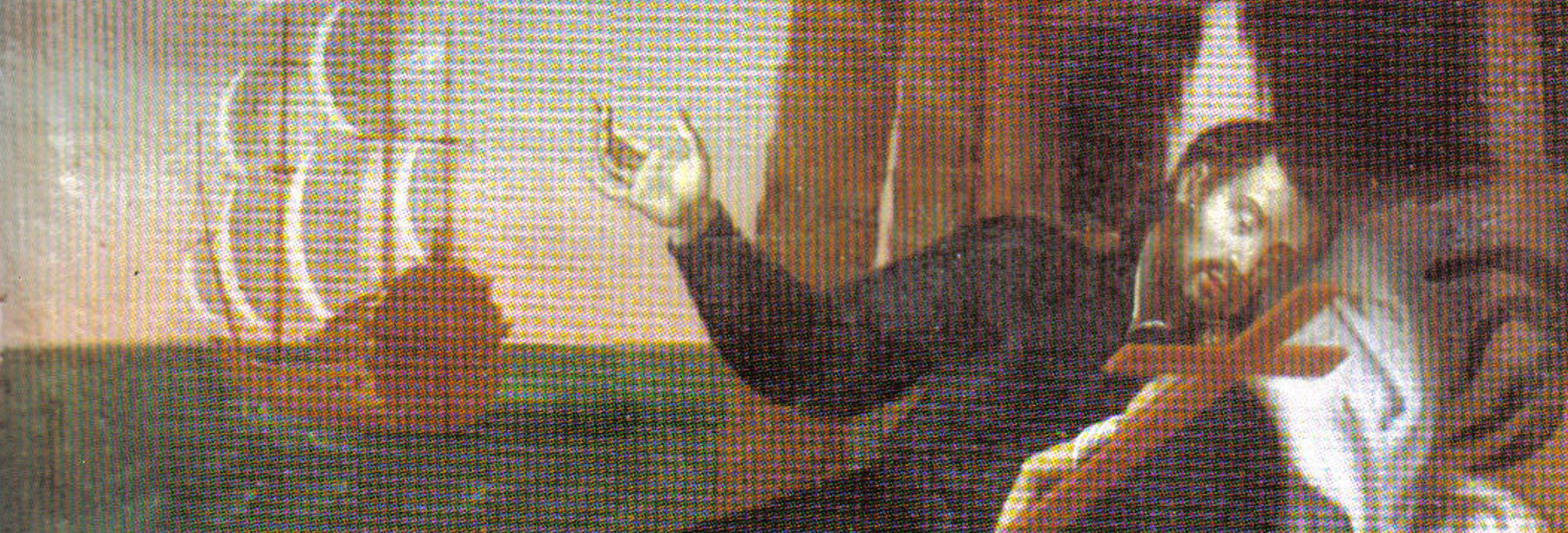
presentation / Chair San Francisco Javier
The outstanding figures of Saint Francis Xavier (1506-1552) and Saint Ignatius of Loyola (Azpeitia, 1491-Rome, 1556), co-founders together with other companions of the Society of Jesus (Societas Iesu), have been the subject of interest in the GRISO's research . When 2006, the 500th anniversary of the birth of St. Francis Xavier, was approaching, we created (together with the St. Francis Xavier Foundation) the Chair St. Francis Xavier to develop a wide programme of activities (congresses, conferences, exhibitions, etc.) and publications (such as, for example, the "Library Services Javeriana"). Now that the Ignatian Year (Ignatius 500) is being celebrated all over the world, on the occasion of the 500th anniversary of the conversion of Íñigo López de Loyola (between 20 May 2021, the anniversary of the wound suffered in Pamplona, and 31 July 2022, the feast of St. Ignatius), and with the prospect of the centenary in Pamplona of the conversion of Íñigo López de Loyola (between 20 May 2021, the anniversary of the wound suffered in Pamplona, and 31 July 2022, the feast of St. Ignatius), and with the prospect of the centenary in 2022 of the canonisations of 1622 by Pope Gregory XV (of the two Jesuit saints, Ignatius and Xavier, but also of Saint Teresa of Jesus, Saint Isidore Labrador and Saint Philip Neri), we are once again devoting attention to both figures of universal transcendence.
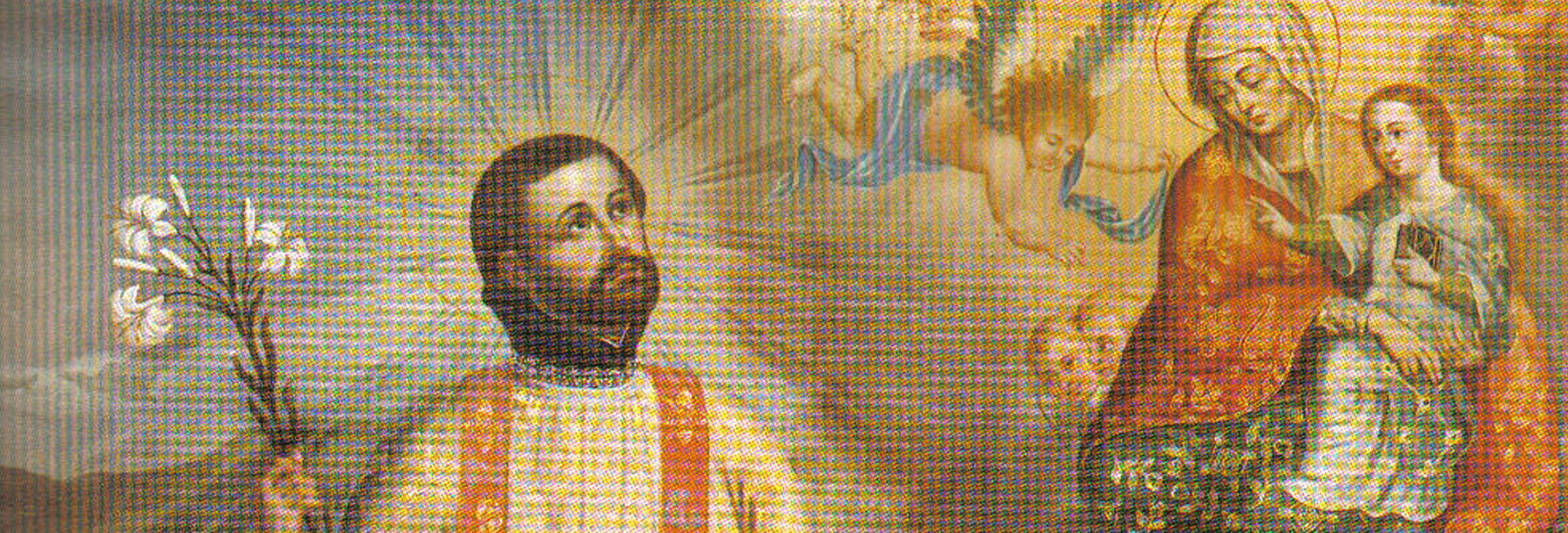
1506 On 7 April, Francis was born in the castle of Xavier, in Navarre.
1512 Conquest of Navarre by the Castilians.
1515 Death of his father. Navarre is incorporated into the Crown of Castile.
1525 Francis travels to Paris to begin his programs of study studies at the Sorbonne.
1529 Meets Ignatius of Loyola.
1531 Graduates in Paris at Philosophy. Begins programs of study in theology.
1534 Pronounces his vows of poverty, chastity and pilgrimage to the Holy Land at Mortmatre, with Ignatius of Loyola and five other companions.
1537 Ordained to the priesthood in Venice, together with Ignatius of Loyola and other companions.
1540 Pope Paul III formally approves the Society of Jesus. Xavier is assigned to the Indies.
1541 On 7 April, his birthday, Xavier left Lisbon for the Portuguese colonies in India as papal representative (his nuncio to the Far East).
1542 On 6 May, Xavier arrived in Goa. From there, for about seven years, he evangelised a large part of southern India, Ceylon, Malacca, etc.
1545 Journey to Malacca.
1546 Travels in the Malay Archipelago, departs for the island of Amboino.
1546 visit the islands of Oceania.
1547 Returns to Malacca.
1548 visit India as Jesuit Provincial.
1549 Xavier sets out for Japan. He arrives in Kagoshima on 15 August and stays there for a year.
1551 Leaves Japan to visit the Indian missions and undertake new projects.
1552 Returns to Goa to prepare for the journey to China. Departs on 17 April.
1552 Landed on Sancian Islet, 150 km from Canton, near Macau, China.
1552 On 3 December, Francis Xavier dies of fever.
1619 He is beatified on 25 October by Pope Paul V.
1621 He is named patron saint of Navarre, a patronage he shares with Saint Fermin of Amiens since 1657.
1622 Francis Xavier is canonised on 12 March by Pope Gregory XV, together with St. Ignatius of Loyola, St. Teresa of Jesus, St. Isidore Labrador and St. Philip Neri.
1904 Pope Pius X names him patron of the Work for the Propagation of the Faith.
1927 Pope Pius XI names him patron saint of the Missions together with St. Therese of the Child Jesus.
1952 Pope Pius XII proclaims him patron saint of tourism.
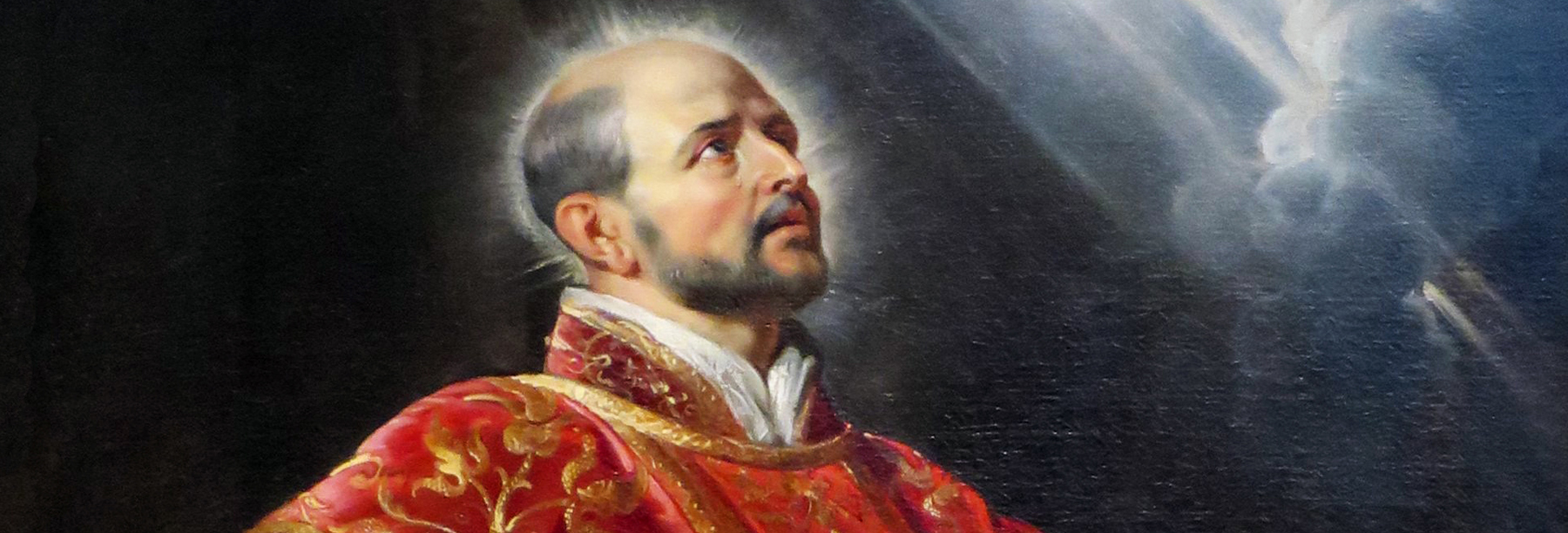
1491 Born in the ancestral home of Loyola (in the parish of Azpeitia, Guipúzcoa) where his family, belonging to the nobility of the lordship of Vizcaya, lived.
1506-1517 He was educated as a knight in the palace of Juan Velázquez de Cuéllar, the major revealer of Castile, in Arévalo (Ávila). In 1507 his father died. In 1515 he is accused of "enormous crimes" in Azpeitia. In 1517 Juan Velázquez de Cuéllar dies.
1521 As a soldier of the Viceroy of Navarre, Antonio Manrique, Duke of Nájera, takes part in the battle against the French troops who were attempting to invade Navarre. He was wounded in both legs while guarding the castle of Pamplona. During his convalescence in Loyola, he decided to consecrate his life to God.
1522-1523 Ignatius begins his pilgrimage: Aránzazu and Monserrat. Retreating to a life of prayer, meditation and penance, he writes the Spiritual Exercises in a cave in Manresa. On the banks of the Cardoner River, he conceives the idea of a religious high school . Pilgrimage to the Holy Land: Barcelona, Rome, Venice, Jerusalem.
1524-1526 Studied Latin and grammar in Barcelona.
1526-1527 He studies logic and the arts in Alcalá de Henares. He begins to give spiritual exercises, an activity for which he is suspected of childbirth, prosecuted and condemned to not preach for three years.
1527 Moved to Salamanca, where he was again tried.
1528 After walking for several months, he arrives in Paris with the intention of studying at its university. He adopts the Latin form (Ignatius) of his given name (Inigo).
1529 Encounters Pedro Fabro and Francisco de Javier.
1529-1531 Three trips to Flanders and one to London to subsidise programs of study.
1532 Receives the Degree de high school program in Arts.
1533 graduate in Arts.
1534 Obtains the Degree of Master of Arts. Gives the month's retreat to Faber, Laínez, Salmerón, Rodrigues, Bobadilla and Xavier. On 15 August, Ignatius and other colleagues take vows of indigence, chastity and apostolic life at Montmartre.
1535 He obtains the degree scroll of magister at Philosophy. Sick, he leaves Paris on his way to Azpeitia. Travels through Spain.
1536 Arrives in Venice to finish his theology programs of study (which he had begun in Paris in 1533).
1537 Gives retreat and is ordained, along with his companions, as a priest in Venice. Vision of the Storta. Enters Rome. Year of waiting for the pilgrimage to Jerusalem.
1538 Celebrates his first mass in Santa Maria Maggiore in Rome. He offers himself and his companions to the pope.
1539 Deliberations for the foundation of the Society of Jesus. Paul III orally approves it and the first companions leave for various places.
1540 By means of the bull Regimini militantis Ecclesiae, Pope Paul III canonically approves, on 27 September, the constitution of the high school of regular clerics of the Society of Jesus, whose statutes he had already verbally approved the previous year. Francis Xavier leaves for India.
1541 Elected Superior General of the Society of Jesus.
1541-1556 Drafts the Constitutions of the Society of Jesus.
1544 Spiritual Diary begins.
1546 Pedro Fabro dies. Admissions Office of Francisco de Borja.
1548 Pope Paul III approves the book of the Spiritual Exercises and they are published.
1550 Pope Julius III confirms the Society's approval.
1551 Founding of high school Romano.
1552 Founding of the Germanic high school . Francisco de Javier dies.
1553 Begins dictating his Autobiography.
1556 Death on 31 July.
1609 Beatified by Pope Paul V.
1622 He is canonised by Pope Gregory XV.
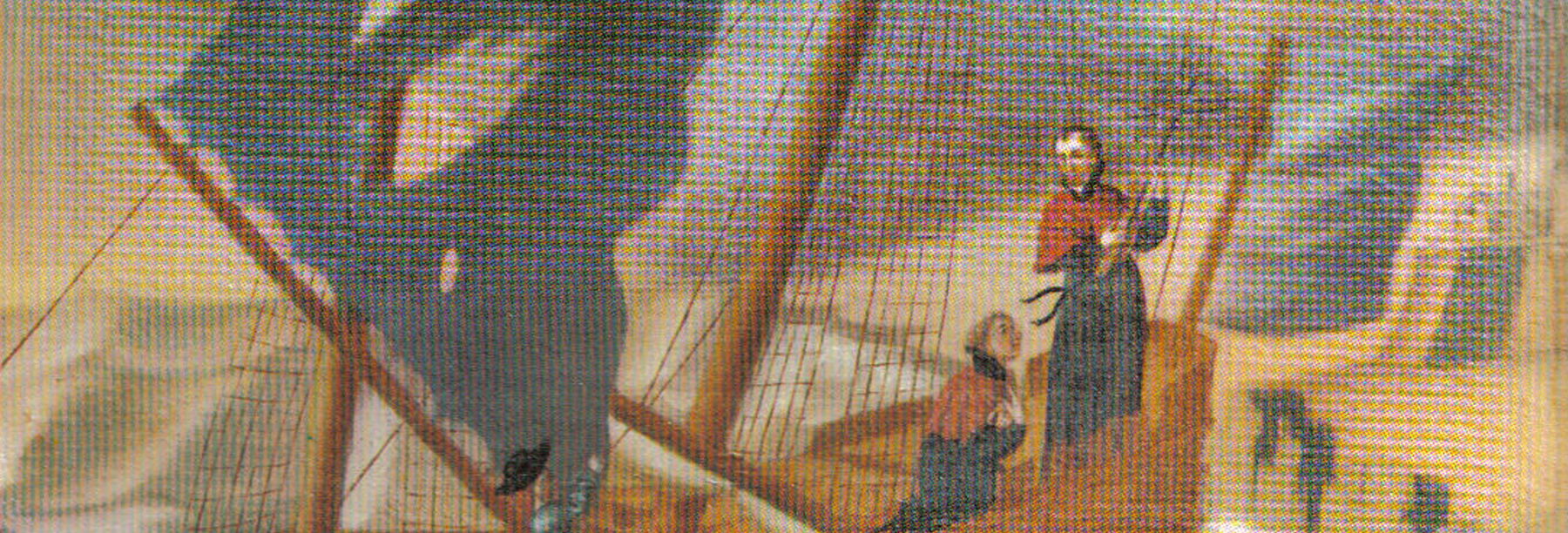
Jesuit theatre or theatre from high school is a corpus of plays from the Golden Age traditionally little known and neglected by critics, although the status has changed in recent decades. They are a series of plays performed in Jesuit schools that seek to teach and entertain, that is, to "delight by making the most of", associated with religious celebrations. They follow classical models: Plautus and Terence for comedy, Seneca for tragedy. The subject matter is religious. The most important work is the Tragedy of St. Hermenegild, with problems of date and authorship. Some of these plays are dedicated to Saint Ignatius of Loyola and/or Saint Francis Xavier.
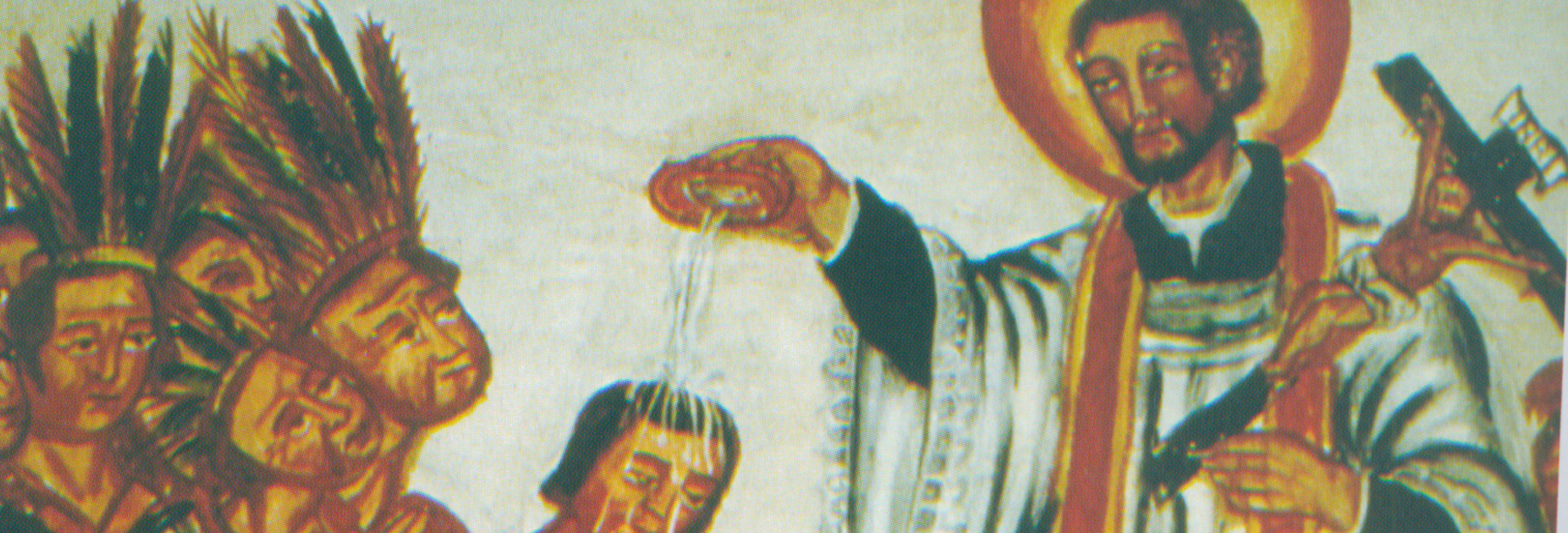
Saint Francis Xavier (1506-1552) is, in addition to being an outstanding historical figure, the most universal saint of Navarre. The study of his rich figure can be approached from many different perspectives: from spirituality and missiology, of course, but also from the historical context of Portuguese expansion in the East Indies; from art and iconography; and also from the field of literature, since the intense life, full of adventures and adventures, of this prodigious "divine adventurer" has inspired numerous authors, from many different periods, in the three genres of narrative, lyric and drama. Indeed, Saint Francis Xavier is the main protagonist or topic main character in numerous novels, poems and dramas.
Likewise, the figure of Saint Ignatius of Loyola can also be approached from multiple perspectives: the foundation of
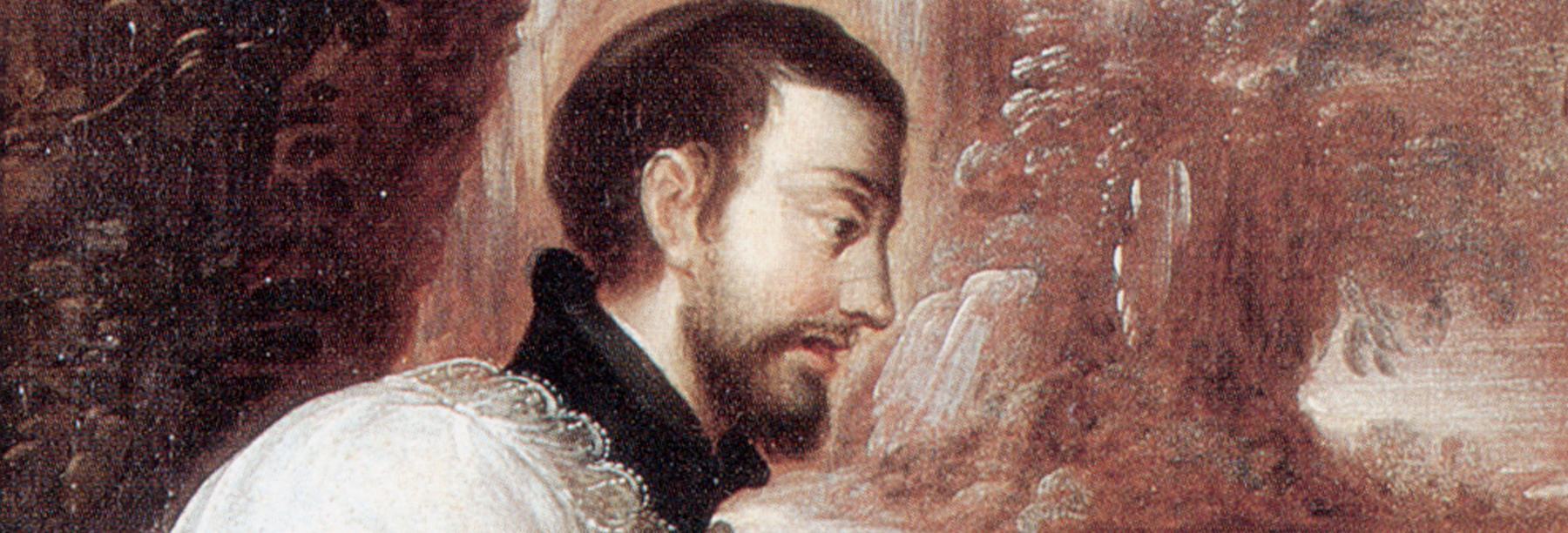
The year 2022 marks the fourth centenary of the canonisations of 1622, when Pope Gregory XV declared Saint Francis Xavier, Saint Ignatius of Loyola, Saint Teresa of Jesus, Saint Isidore Labrador and Saint Philip Neri saints. The group of research Siglo de Oro (GRISO) of the University of Navarra, in coordination with the Society of Jesus (which is currently celebrating the Ignatian Year "Ignatius 500"), plans to organise a series of activities on the occasion of this important anniversary, focusing on the two Jesuit figures of greatest transcendence and universal relevance: Saint Francis Xavier and Saint Ignatius of Loyola, to whom we already devoted attention in 2006 (on the occasion of the centenary of the birth of Saint Francis Xavier) through a wide range of activities (books, congresses, conference cycles, exhibitions and other informative activities), for which we had the support of the Government of Navarre partnership . The new programme of activities planned for 2022 also includes various publications, exhibitions and informative activities (to be held in Pamplona, Javier and Loyola) and, above all, an international congress , academically coordinated by the GRISO, planned for autumn 2022, for which leading specialists in Jesuit culture and hagiography will be present. This congress will be held at the University of Navarra, with the possibility of extending some of the sessions to other parts of the city and to Javier and Loyola.
Library Services Javeriana
During the years 2004-2005, at partnership with the Diario de Navarra Foundation, we published a selection of texts and programs of study on Saint Francis Xavier. These are the titles published:
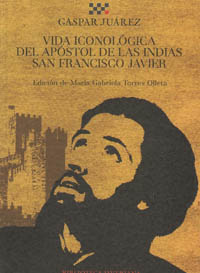
Juárez, Gaspar, Vida iconológica del apóstol de las Indias San Francisco Javier, de la Compañía de Jesús, ed. by María Gabriela Torres Olleta, Pamplona, Ediciones y Libros / Fundación Diario de Navarra, 2004 (Library Services Javeriana, 1). ISBN: 84-933821-0-8.
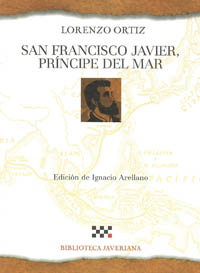
Ortiz, Lorenzo, S.I., San Francisco Javier, príncipe del mar, ed. by Ignacio Arellano, Pamplona, Ediciones y Libros / Fundación Diario de Navarra, 2004 (Library Services Javeriana, 2). ISBN: 84-933821-1-6.
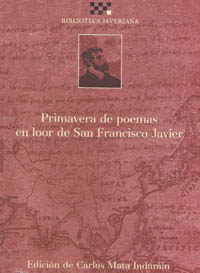
Primavera de poemas en loor de San Francisco Javier, ed. by Carlos Mata Induráin, Pamplona, Ediciones y Libros / Fundación Diario de Navarra, 2004 (Library Services Javeriana, 3). ISBN: 84-933821-2-4.
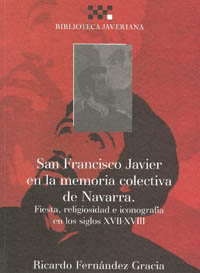
Fernández Gracia, Ricardo, San Francisco Javier en la report colectiva de Navarra: fiesta, religiosidad e iconografía en los siglos XVII-XVIII, Pamplona, Ediciones y Libros / Fundación Diario de Navarra, 2004 (Library Services Javeriana, 4). ISBN: 84-933821-3-2.
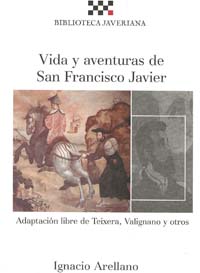
Arellano, Ignacio, Vida y aventuras de San Francisco Javier (free adaptation by Teixeira, Valignano and others), Pamplona, Ediciones y Libros / Fundación Diario de Navarra, 2005 (Library Services Javeriana, 5). ISBN: 84-933821-4-0.
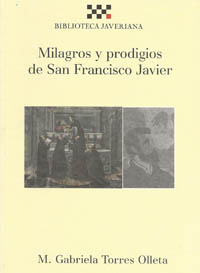
Torres Olleta, María Gabriela, Milagros y prodigios de San Francisco Javier, Pamplona, Ediciones y Libros / Fundación Diario de Navarra, 2005 (Library Services Javeriana, 6). ISBN: 84-933821-5-9.
Other publications
We offer here a list of other publications (books, articles and book chapters) related to St. Francis Xavier, St. Ignatius of Loyola, Jesuit theatre and Jesuit culture in general. When available in Open Access, we provide links to the full texts of these works.
Books
-
Arellano, Ignacio, and Mata Induráin, Carlos (eds.), St Francis Xavier and the Jesuit Missionary Enterprise. Assimilations between Cultures / San Francisco Javier y la business misionera jesuita. Assimilations between Cultures, Pamplona, Publishing Services of the University of Navarra, 2012 (Library Services Áurea Digital, BIADIG, 15). ISBN: 978-84-8081-338-9.
-
Céspedes, Valentín de, Las glorias del mejor sigloed. by Ignacio Arellano, Pamplona, Publishing Services of the University of Navarra, 2012. ISBN: 978-84-8081-261-0.
-
Calleja, Diego, El Fénix de España, San Francisco de Borja, ed.ed. by Ignacio Arellano, Pamplona, Publishing Services of the University of Navarra, 2012.
-
Anonymous, San Javier Grande en El Hitoed. by Mariela Insúa Cereceda and Carlos Mata Induráin, Pamplona, Publishing Services of the University of Navarra, 2010 (Library Services Áurea Digital, BIADIG, 4). ISBN: 84-8081-209-5.
-
Calderón de la Barca, Pedro, El gran duque de Gandía (apocryphal), ed. by Ignacio Arellano, Kassel, Reichenberger, 2010. ISBN: 9783937734798.
-
Torres Olleta, María Gabriela, Redes iconográficas: San Francisco Javier en la cultura visual del Barroco , Madrid / Frankfurt am Main, Iberoamericana / Vervuert, 2009. ISBN: 978-84-8489-453-7.
-
Arellano, Ignacio, and Mendonça, Delio (eds.), mission statement y aventura. San Francisco Javier, sol en Oriente, Madrid / Frankfurt am Main, Iberoamericana / Vervuert, 2008. ISBN: 978-84-8489-358-5 (Iberoamericana) and 978-38-6527-435-9 (Vervuert).
-
Arellano, Ignacio, Alejandro González Acosta and Arnulfo Herrera (eds.), San Francisco Javier entre dos continentes, Madrid / Frankfurt am Main, Iberoamericana / Vervuert, 2007. ISBN: 9788484892908 (Iberoamericana) / 9783865273246 (Vervuert).
-
Arellano, Ignacio (ed.), San Francisco Javier, el Sol en Oriente, comedia jesuítica del P. Diego Calleja, Madrid / Frankfurt am Main, Iberoamericana / Vervuert, 2006. ISBN: 8484892301 (Iberoamericana) / 3865272479 (Vervuert).
-
Arellano, Ignacio, Life and Adventures of St. Francis Xavier. Free Adaptation of Teixeira, Valignano and OthersAparajit Chatophaydhay, New Delhi, CB Processor and Publishers, 2006.
-
Mata Induráin, Carlos, Two dramatic pieces by Genaro Xavier Vallejos about San Francisco Javier: "Volcán de amor" (1923) and "Xavier. Estampas escénicas" (1930). Study and editionin San Francisco Xabier desde sus tierras de Navarra. Celebración del V Centenario (1506-2006), Sangüesa, group Cultural Enrique II de Albret, 2006.
-
Arellano, Ignacio, (coord.), Sol, Apóstol, Peregrino, San Francisco Javier en su Centenario, Pamplona, Gobierno de Navarra (department de Cultura y Turismo-Institución Príncipe de Viana), 2005. ISBN: 8423528081.
-
Torres Olleta, María Gabriela, Vita thesibus et Vita iconibus: dos certámenes sobre San Francisco Javier, Kassel / Pamplona, Edition Reichenberg / Universidad de Navarra (School de Philosophy y Letras, Chair de Patrimonio y Arte Navarro), 2005. ISBN: 83937734236.
-
Torres Olleta, María Gabriela, Relación de un prodigioso milagro de San Francisco Javier en Nápoles, Pamplona, GRISO-Universidad de Navarra, 2003.
-
Arellano, Ignacio, and Torres Olleta, María Gabriela, The prodigy of two worlds, Saint Francis Xavier and the "Sacred Parnassus of Catholic Muses"Pamplona, GRISO-University of Navarre, 2002.
Articles
-
Mata Induráin, Carlos, "San Francisco Javier taumaturgo: la zarzuela anónima San Javier grande in El Hito", Rilce. Revista de Philology Hispánica, 29.3, 2013, pp. 669-688.
-
Arellano, Ignacio, "El gran duque de Gandía, San Francisco de Borja, en el teatro del Siglo de Oro", Criticón, 110, 2010, 217-246.
-
Arellano, Ignacio, "¿Es The Grand Duke of Gandía (auto) de Calderón?", bulletin de la Real Academia Española, 90, 302, 2010, pp. 195-216.
-
Arellano, Ignacio, "América en las fiestas jesuitas. Celebraciones de San Ignacio y San Francisco Javier", Nueva Revista de Philology Hispánica, 56, 2008, pp. 53-86.
-
Lluch Villalba, María Ángeles, and Mata Induráin, Carlos, "San Ignacio de Loyola en el teatro español del siglo XX: El caballero de Dios Ignacio de Loyola (1923) de Juan Marzal, SI y El capitán de sí mismo (1950) de Manuel Iribarren", yearbook del high school Ignacio de Loyola, 13, 2006, pp. 315-337.
-
Mata Induráin, Carlos, "Un baile de las merindades de Navarra (y otras referencias a Sangüesa) en el poema , de Bernardo Monzón", Zangotzarra, 10, 2006, pp. 168-183. Xaveriadasby Bernardo Monzón", Zangotzarra, 10, 2006, pp. 168-183.
-
Mata Induráin, Carlos, "San Ignacio de Loyola, entre historia y literatura (I). El Siglo de Oro", yearbook del high school Ignacio de Loyola, 13, 2006, pp. 145-176.
-
Mata Induráin, Carlos, "San Francisco Javier y don Quijote de la Mancha. Some parallels", Pregón Siglo XXI. Revista Navarra de Cultura, 28, Winter 2006, pp. 100-102.
-
Mata Induráin, Carlos, "San Francisco Javier y Mozart, unidos por el prodigio y la universalidad", Pregón Siglo XXI. Revista Navarra de Cultura, 27, Summer 2006, pp. 37-39.
-
Mata Induráin, Carlos, "San Francisco Javier y la inculturación: notas históricas y literarias", yearbook del high school Ignacio de Loyola, 12, 2005, pp. 103-123.
Book chapters
-
Arellano, Ignacio, "Life and Adventures of St. Francis Xavier. Free Adaptation of Teixeira, Valignano and Others", in Ignacio Arellano (ed.), Modelos de vida y cultura en la Navarra de la modernidad temprana, New York, high school de programs of study Auriseculares (IDEA), 2016, pp. 11-47.
-
Arellano, Ignacio, "Short dramatic pieces about St. Francis Xavier in the Golden Age. Los nueve Diálogos de la Real Academia de la Historia de Madrid", in Mariela Insúa (ed.), Modelos de vida y cultura en Navarra (siglos XVI y XVII). Antología de textos, Pamplona, Publishing Services de la Universidad de Navarra, 2016, pp. 13-92.
-
Mata Induráin, Carlos, "Los agravios satisfechos del Desengaño y la Muerte, colloquium moral con ocasión de la canonización de San Francisco de Borja", in Pavel Štěpánek (ed.), Svatý František Xaverský a jezuitská kultura v českých zemích, Olomuc, Universzita Palackého v Olomouci [Palacky University Press], 2014, pp. 147-156.
-
Arellano, Ignacio, "Theatrical Elements in Baroque Festivals (The Jesuit celebrations in the Golden Age)", in Ignacio Arellano and Carlos Mata Induráin (eds.), St Francis Xavier and the Jesuit Missionary Enterprise. Assimilations between Cultures / San Francisco Javier y la business misionera jesuita. Asimilaciones entre culturas, Pamplona, Publishing Services de la Universidad de Navarra, 2012, pp. 47-56.
-
Mata Induráin, Carlos, "Una epidemia de peste, un milagro javeriano y una villa agradecida: la zarzuela anónima San Javier grande en El Hito", in Ignacio Arellano and Carlos Mata Induráin (eds.), St Francis Xavier and the Jesuit Missionary Enterprise. Assimilations between Cultures / San Francisco Javier y la business misionera jesuita. Asimilaciones entre culturas, Pamplona, Publishing Services de la Universidad de Navarra, 2012, pp. 125-144.
-
Arellano, Ignacio, "Vive le roy! El poder y la gloria en fiestas hagiográficas francesas (canonización de San Ignacio y San Francisco Javier, 1622)", in Ignacio Arellano, Edwin Williamson and Christoph Strosetzki (eds.), Autoridad y poder en el Siglo de Oro, Madrid / Frankfurt am Main, Iberoamericana / Vervuert. 2009, pp. 9-34.
-
Arellano, Ignacio, "Diálogos javerianos de la Real Academia de la Historia de Madrid. II. Los diálogos de Goa", in Ignacio Arellano and Delio Mendonça (eds.), mission statement y aventura. San Francisco Javier, sol en Oriente, Madrid / Frankfurt am Main, Iberoamericana / Vervuert, 2008, pp. 37-58.
-
Mata Induráin, Carlos, "Tres vidas en verso de San Francisco Javier: Matías Vivero (1620), Francisco de Lancina (1682) y José de Villarroel (1736)", in Ignacio Arellano and Delio Mendonça (eds.), mission statement y aventura. San Francisco Javier, sol en Oriente, Madrid / Frankfurt am Main, Iberoamericana / Vervuert, 2008, pp. 197-221.
-
Arellano, Ignacio, "San Francisco Javier y Las glorias del mejor siglo, comedia jesuítica del P. Céspedes", in Ignacio Arellano, Alejandro González Acosta y Arnulfo Herrera (eds.), San Francisco Javier entre dos continentes, Madrid / Frankfurt am Main, Iberoamericana / Vervuert, 2007, pp. 11-34.
-
Arellano, Ignacio, "La risa en las comedias jesuíticas sobre San Francisco Javier", in São Francisco Xavier, Porto, Centro Interuniversitario de Historia da espiritualidades, 2007, pp. 7-26.
-
Arellano, Ignacio, "Diálogos javerianos de la Real Academia de la Historia de Madrid. III. El martirio ejemplar del príncipe de Ceilán", in Estudos para Maria Idalina Rodriges, Maria Lucilia Pires, Maria Vitalina Leal de Matos, Lisbon, Universidade de Lisboa, 2007, pp. 319-336.
-
Arellano, Ignacio, "Notas sobre América en fastos hagiográficos de San Ignacio y San Francisco Javier", in La fiesta. report del IV meeting internacional sobre Barroco, La Paz, Fundación Visión Cultural / /Publishing Services de la Universidad de Navarra, 2007, pp. 245-253.
-
Mata Induráin, Carlos, "San Francisco Javier en el teatro español del siglo XX: Volcán de amor (1922) de Vallejos y El divino impaciente (1933) de Pemán", in Ignacio Arellano, Alejandro González Acosta y Arnulfo Herrera (eds.), San Francisco Javier entre dos continentes, Madrid / Frankfurt am Main, Iberoamericana / Vervuert, 2007, pp. 133-150.
-
Mata Induráin, Carlos, "Una evocación dramático-musical de San Francisco Javier: Xavier. Estampas escénicas (1930), de Genaro Xavier Vallejos", in Navarra: report e imagen. conference proceedings del VI congress de Historia de Navarra, Pamplona, September 2006, Pamplona, Sociedad de programs of study Históricos de Navarra (SEHN) / Ediciones Eunate, 2006, vol. II, pp. 245-255.
-
Arellano, Ignacio, "San Francisco Javier en el teatro del Siglo de Oro", in Ignacio Arellano (coord.), Sol, Apóstol, Peregrino, San Francisco Javier en su Centenario, Pamplona, Gobierno de Navarra (department de Cultura y Turismo-Institución Príncipe de Viana), 2005, pp. 239-266.
-
Mata Induráin, Carlos, "San Francisco Javier en la poesía española del Siglo de Oro", in Ignacio Arellano (coord.), Sol, Apóstol, Peregrino, San Francisco Javier en su Centenario, Pamplona, Gobierno de Navarra (department de Cultura y Turismo-Institución Príncipe de Viana), 2005, pp. 267-285.
Congresses and other activities
Co-organised by the Chair of Art History of the Univerzita Palackého and GRISO-University of Navarra, Olomouc (Czech Republic), Univerzita Palackého, 17-18 May 2012.
Organised by GRISO-University of Navarra and sponsored by the Government of Navarra, Goa (India), International Centre Goa, 1-3 December 2011.
Pamplona, Servicio de Bibliotecas de la Universidad de Navarra, 2008, organised by Gabriela Torres Olleta, José María Torres Pérez, María Calonge Domínguez and María Teresa Alli Cruz. + info
(GRISO-University of Navarra, University of Delhi, Jawaharlal Nehru University and Xavier Centre of Historical Research), Goa (India), International Centre Goa, 22-25 January 2007.
(Government of Navarra), Pamplona (Spain), file General de Navarra, 8-11 November 2006.
Organised by the University of Navarra (Chair San Francisco Javier) in partnership with the Ateneo Jovellanos de Gijón, Gijón (Spain), Ateneo Jovellanos, May 2006.
Pamplona (Spain), area de Cultura del Ayuntamiento de Pamplona, March-April 2006.
Co-organised by the National Autonomous University of Mexico (UNAM), the Ibero-American University of Mexico and GRISO-University of Navarra, Mexico City (Mexico), Ibero-American University of Mexico, 29 January-1 February 2006.
Organised by the Chair San Francisco Javier in partnership with the Town Council of Sangüesa, Sangüesa (Spain), Casa de Cultura, 5 November 2004.
